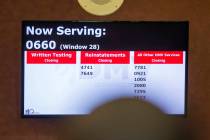The school district’s new five-year plan
In our public schools, a small number of hard-working kids, encouraged by parents who put an emphasis on achievement, continue to do well. Our trade and career high schools are another bright spot.
But at most government-run Las Vegas schools, as in most of urban America, results range from mildly disappointing to deplorable.
School reformers often talk of "raising the bar." It's a metaphor borrowed from track and field. Give the young high-jumper confidence by showing him or her how to get over a 5-foot bar. Then work on technique and strength training till the athlete can jump the 6-foot bar. Keep raising it.
That was the idea behind the federal education reform called "No Child Left Behind."
When the program first went into effect, the bar was low: Only one-third of elementary kids needed to score at grade level in math for a school to "meet standards" in 2002-03. But then the bar was raised: Requirements gradually increased, until the standards call for 100 percent of students to demonstrate proficiency in math, reading and English by 2013-14.
Remember that part about "Work on technique and strength training"? Without that, eventually you reach the point where most kids just knock down the bar.
After a decade of easy stuff, "No Child Left Behind" was finally supposed to start paying off next year. And like the football coach who starts a five-year rebuilding program and delivers nothing but four losing seasons, the program has now packed its van and is on its way out of town.
Less than a third of Clark County schools made the grade under No Child Left Behind in the 2011-12 academic year, marking a new low for the country's fifth-largest district.
Because the standards were raised every year, results simply got worse every year.
"For that reason, it's not a surprise," says School Board President Linda Young. (The requirement that 100 percent of students demonstrate proficiency in math, reading and English? No school can achieve that, Ms. Young says.)
So, educators have come up with a whole new way to measure student achievement in Nevada.
Starting this school year, Nevada and 32 other states have been issued a waiver from those federal standards, and will instead grade schools using their own systems approved by the U.S. Department of Education.
Nevada's new requirements use a 100-point "index" system for measuring student performance, and will award schools one to five stars - a system the Clark County School District initiated last school year.
The 100-point index will be based on students' academic growth; number of students achieving at grade level; reductions in gaps between groups of commonly struggling students, and "student engagement."
Now the state has "set a new bar" that requires the percentage of students with grade-level skills to increase from 50 percent to 90 percent by the 2016-17 school year. To get there, it has adopted a new curriculum, Common Core Standards, used by all but a few states.
The new plan offers a better, more nuanced measure of academic success - especially with its stress on tracking individual student progress, year-by-year, with teachers evaluated in part based on that progress.
An 80 percent improvement in the percentage of students performing at grade level by 2017? It's really a minimum requirement, if Nevada graduates are going to prosper in a competitive world market. All involved need to knuckle down and get it done.

















